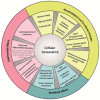Senotherapeutics in Cancer and HIV
- PMID: 35406785
- PMCID: PMC8997781
- DOI: 10.3390/cells11071222
Senotherapeutics in Cancer and HIV
Abstract
Cellular senescence is a stress-response mechanism that contributes to homeostasis maintenance, playing a beneficial role during embryogenesis and in normal adult organisms. In contrast, chronic senescence activation may be responsible for other events such as age-related disorders, HIV and cancer development. Cellular senescence activation can be triggered by different insults. Regardless of the inducer, there are several phenotypes generally shared among senescent cells: cell division arrest, an aberrant shape, increased size, high granularity because of increased numbers of lysosomes and vacuoles, apoptosis resistance, defective metabolism and some chromatin alterations. Senescent cells constitute an important area for research due to their contributions to the pathogenesis of different diseases such as frailty, sarcopenia and aging-related diseases, including cancer and HIV infection, which show an accelerated aging. Hence, a new pharmacological category of treatments called senotherapeutics is under development. This group includes senolytic drugs that selectively attack senescent cells and senostatic drugs that suppress SASP factor delivery, inhibiting senescent cell development. These new drugs can have positive therapeutic effects on aging-related disorders and act in cancer as antitumor drugs, avoiding the undesired effects of senescent cells such as those from SASP. Here, we review senotherapeutics and how they might affect cancer and HIV disease, two very different aging-related diseases, and review some compounds acting as senolytics in clinical trials.
Keywords: HIV; SASP; cancer; senescence; senolytic; senostatic; senotherapy.
Conflict of interest statement
The authors declare that this research was conducted in the absence of any commercial or financial relationships that could be construed as potential conflicts of interest.
Figures





